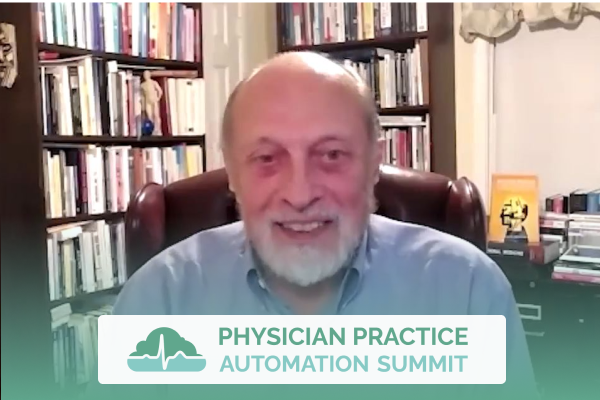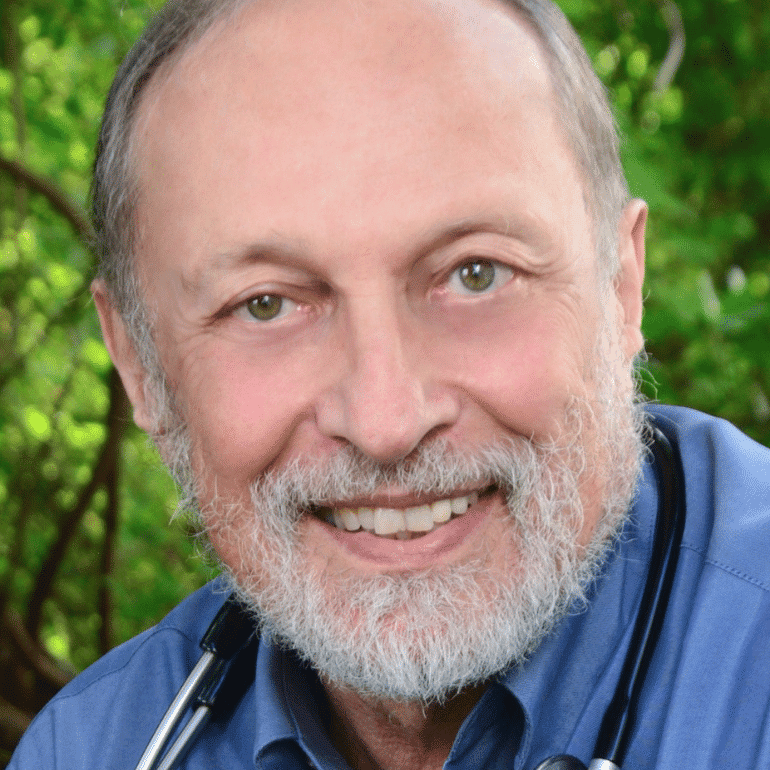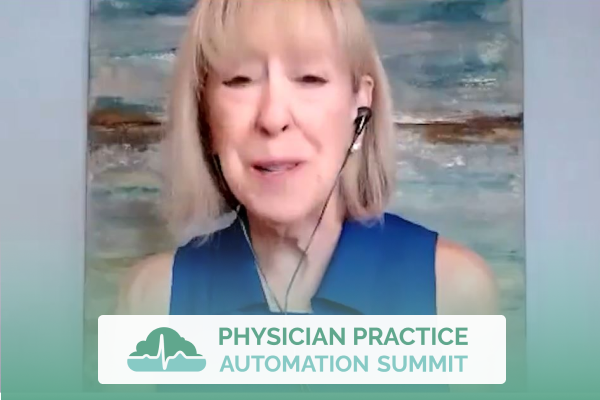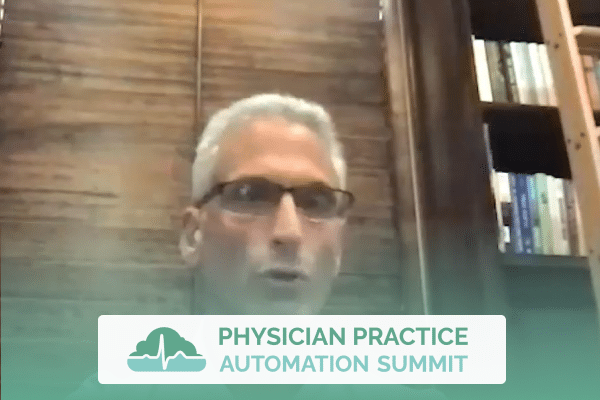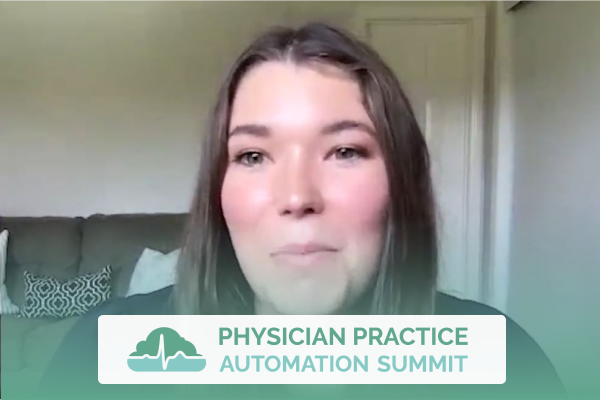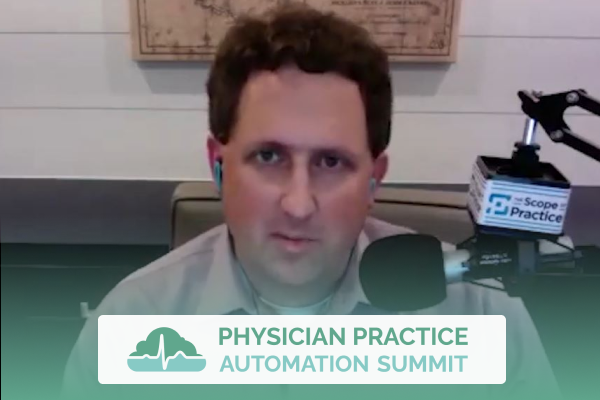Join the discussion below
Cheng-Huai Ruan, M.D.
On this segment, we have Dr William Pawluk. He’s a great friend of mine. He is a world renowned leader in pulse electromagnetic field therapy. So, why is he on the Physician Practice Automation Summit? Well, because he kind of does things outside the box and what I would really want to know, what are some ways to de-risk ourselves as physicians when we want to think outside the box? Adopting technologies for things that really benefit for our patients. So Dr Pawluk is the MD. He’s a board certified family medicine physician in Maryland just outside of Baltimore and he is on academic appointments at Johns Hopkins University as well as the University of Maryland, and he’s had holistic training in acupuncture and homeopathy and hypnosis and all sorts of really cool stuff and but what he does the best on is PEMF therapy, pulse electrical magnetic field therapy.
William Pawluk, M.D.
Thank you very much Cheng, it’s a pleasure to be here as well and share great information with another like-minded, smart guy.
Cheng-Huai Ruan, M.D.
Thanks for that and everyone on the Summit’s pretty smart because the Summit is for physicians and one of the things that really got to me was that during the pandemic, a lot of people really came to me and not understanding how to pivot within the stress of the pandemic and I do think one of the root issues is that a lot of doctors don’t really necessarily know how to adapt onto new technology. Whether it’s technology to sort of run the practice or like clinical, technology like such as, the PEMF that we’re about to talk about, right. And so the main culprit here is that as MDs, we’re trained in sort of this institutionalized education.
There’s a hierarchy, right. You got your medical school, you got your internship, you got your residency, you got your fellowship and then you have these guidelines and we kind of abide by these guidelines that are there and then, some somewhere along the way or attending stages that you go outside of these guidelines you’re gonna get spanked, by somebody. Some invisible person that’s right there. Right, and I think that it takes a lot away the creativity that’s behind us and therefore there’s almost a scare of adopting new things because our mindset’s not really trained in that direction, right. And so, we talked before about several different topics but when EMFs and PEMFs came onto the scene, it really intrigued me. So can you kind of introduce to the audience exactly what that is?
William Pawluk, M.D.
What PEMFs are and what EMFs are?
Cheng-Huai Ruan, M.D.
EMFs, yeah.
William Pawluk, M.D.
Okay so, EMF stands for electromagnetic fields. Now, currently the term EMF is being used primarily to talk about… I call environmental magnetic fields. So it’s electromagnetic but it’s environmental electromagnetic fields and they include things like microwaves, radio waves, television waves, radar in fact, over the horizon radar if you’re happy to be downstream from one of these radars then you’re… it’s a form of EMF but probably the most important EMF that we have around us that we’re using all the time is cell phones and the connections to cell phones including WiFi, Bluetooth and also smart meters next to our homes, so that’s all basically in the WiFi world and that’s essentially microwave.
Now we have other kinds of strain magnetic fields that relate to power lines and they’re not as bad. They’re bad because we’re bathed in those environments all day long. If you work in an office building you have power going through your whole building. You have lights and so on. Those are other forms of EMFs but they’re not as bad in a sense because they don’t tend to be absorbed. So, microwaves are absorbed. The wavelengths are very, very short, and because they’re very short, they get absorbed by the body, they don’t pass all the way through the body. That’s how microwave ovens work. The microwaves are absorbed and they heat the tissue. Same with a cell phone, if you put a cell phone to your ear, your ear will turn red. If you look at the other ear it’ll be, maybe slightly more red, but if you if you put your cell phone on airplane mode and put it next to your ear it won’t turn red.
So what you’re doing effectively is you’re baking your ear and therefore you’re baking the structures inside, in the head within a certain distance because of the microwaves. PEMFs, pulsed electromagnetic fields are therapeutic magnetic fields. They’re designed to be therapeutic. They’re extremely short wavelengths but unlike microwaves and unlike radio waves, where you have microwave towers broadcasting, whatever the G is, whether it’s 4G, 5G or whatever the G is going to be in the future, they’re broadcasting the environment. So they’ve been bounced off the ionosphere and they’re coming back down and onto the planet, they’re staying within the ionosphere, so we’re subject to those radiations all the time. They’re not ionizing radiation but they’re radiation.
Now, magnetic field therapy from PEMFs, for clinical use, is in a wire. It’s a current in a wire and that current flowing through that wire produces a perpendicular magnetic field to the flow of the current. That is a closed loop. So microwaves, radio waves, all these other EMFs are basically open loop. PEMFs are closed loop. So basically, as the pulse goes through it, the wave expands and condenses, collapses. Expands, collapses, expands, collapses so it doesn’t go out in the atmosphere, so therefore it’s got a relatively limited distance with when it should… with when which it works, okay, those are the primary differences between those two types of if you will EMFs, PEMFs and EMFs.
Cheng-Huai Ruan, M.D.
Gotcha. So I think that there’s a… the misconception is that all EMFs are the same. And I kind of blew it off when I first learned about it. So I first learned about EMS in general and in residency in New York where we had this patient that didn’t allow any of the residents to bring in the cell phones and stuff like that. He’s a stage four cancer patient on chemotherapy and I’m like, “Okay, I don’t know what this is all about, we’ll respect you, we’ll keep it outside,” and then I got into the rabbit hole because I started looking at research and data behind it and then, I just found a whole lot of things that I didn’t really, weren’t really educated about and then I came across PEMF therapy right after a residency where once again it’s another cancer patient with also a history of for my brain injury.
We’re doing this PEMF therapy with a physician in Brooklyn and so, I started asking, okay, what is this really all about? I kind of got into a little bit because, I think the popular consensus amongst the people, amongst a lot of doctors I know is that’s just a big black box. We don’t exactly know what it is so, I mean here’s the question like, is PEMF therapy, is that is that a real thing? Is that something that has political outcomes? Can you kind of explain the science behind that?
William Pawluk, M.D.
Sure, I started working with magnetic fields 30 years ago because I was trying to find solutions for pain management that did not involve drugs or procedures and discovered through my training, I took acupuncture training and in 1990 people didn’t know what acupuncture was and stay away from me with those needles. So I said well, let me find ways of doing acupuncture that do not involve needles and lo and behold in the orient they’ve also been using magnets on acupuncture points.
Cheng-Huai Ruan, M.D.
Yes.
William Pawluk, M.D.
Right, so I started using magnets on acupuncture points and I started using magnets on sore spots, on skin lesions and so on and lo and behold they worked. So I said, what is this? What is this phenomenon doing? How does it work? Unfortunately, at that time, the science was largely in Cyrillic, it was Russian, eastern European or Chinese Oriental languages or German etc so, basically, hidden from the western mind. and I met a colleague from the Czech Republic, an MD PHD, who did his thesis, PHD thesis, PHD work on electromagnetics so he translated a lot of that literature and he said, I have a manuscript, sent me the manuscript.
We worked with the manuscript and produced a book called Magnetic Field Therapy in Eastern Europe, A Review of 30 Years of Research. Now we had the research that was actually done 30, at that time as 30 years ago, now it’s like 50 years ago, so that science has been around for a long time. Unfortunately it’s been sort of back room. Subsequently I wrote a book, the book’s behind me there, magnetic fields, basically how they work. The book is called Power Tools for Health. In that book, I wrote the book collecting together as much science as I could and I have over 500 references in the book on clinical studies that have been done on magnetic field therapies.
Most of the ones that I quote are controlled trials. They’re not all randomized but they’re controlled in various fashions and through my own research, review of the literature that’s out there, there’s a huge literature, most of it is basic science,, not a lot of it, not as much of it as what I would like to see is clinical science but still, it still allowed me to produce a book with 500 references in it. So there are at least 27, 28 mechanisms of action of PEMFs, basic, biologic actions of PEMFs and then the clinical studies. In the book then I had 50 clinical conditions that then are basically supported with clinical evidence. So there’s a substantial body of evidence on the effectiveness of PEMFs to heal tissue.
Cheng-Huai Ruan, M.D.
Let’s talk about what’s already adopted within medicine, so let’s… my mom’s an acupuncturist by the way, so playing with magnets and stuff like that for joints it’s something I grew up with, because I was born, spent my childhood in China, so that was something that that I already knew about and so, but then I came across the technology which is TMS, transcranial magnetic stimulation. So, is that also a PEMF or is that something different?
William Pawluk, M.D.
It’s the same. It’s part of the same spectrum.
Cheng-Huai Ruan, M.D.
Okay.
William Pawluk, M.D.
MRI, in fact there was a study done at McLean Hospital in Boston where they discovered that people who are getting magnetic resonance studies, being studied from magnetic resonance using MRI type technology. We’re getting benefits to their depression, so that’s one aspect. Even MRI could theoretically be therapeutic and we know it has a risk with burning because of the radio frequencies involved with it but the huge static magnetic field causes basically no harm except for projectiles so if you don’t watch for that, but then TMS was discovered by a guy named barker in the UK back in the ’60s. Transcranial magnetic stimulation and one of the purposes behind the TMS was to get away from ECT, electroconvulsive therapies for all kinds of psychological conditions, paranoia, schizophrenia, psychosis and so on.
That’s relatively barbaric causing significant muscle contractions, fractures, all kinds of problems. So they want to get away from that and discover that TMS can do intracranial electrical stimulation. So essentially, PEMFs are inductively coupled magnetic field stimulation. They’re elect inductively called electrical stimulation. So they’re inducing charge in the body, they’re inducing charge in the brain and charge will travel through planes and they’ll travel down molecular pathways and so on. It’ll travel down nerves so, that’s what TMS is basically and particularly for depression. So using TMS in the left frontal lobe, primarily that area, they thought the magnetic fields would depolarize tissues and basically help with the symptoms of depression. So TMS is now being studied for all sorts of neurological conditions, Parkinson’s, MS, TBI.
I did a review article, I published a review article on uh TMS being used for TBI and concussion. It’s a pretty substantial literature now showing the benefits of that for TBI. Right, so, it’s inducing charge and that’s basically the principle that I work off is that most of the therapeutic value of PMS, the way I conceive of it has more to do with the induced charge in the body. So when you press, pass a magnetic field past electrolytes, pass conductors of any kind based on Faraday’s law, you’re inducing charge in the tissue. When you use charge the body has more energy to be able to do the work that it needs to do to rebuild and rebalance. So, TMS is one application, it’s also been used for non-healing fractures, non-unions.
So that was approved by 25 years ago. Relatively low intestine magnetic fields have been used to heal fractures that won’t unite. So after six months a fracture is considered a non-union if it hasn’t healed, right and PEMFs have been shown to heal those fractures within six months to a year and now it’s being used for bone grafting in the spine, it’s being studied for other types of bone healing and lots of studies now are showing that magnetic field therapy can actually heal fractures probably about half the time that it would normally take it.
Cheng-Huai Ruan, M.D.
That’s great. It’s interesting because, you talked about TBI, traumatic brain injury, you talked about non-human fractures. These are cellular mechanisms of repair. That’s pretty much universal to our whole body, right and so, when I studied PEMF therapy for the patient that I had with cancer on the cellular component, I was able to really appreciate what it actually did on the cellular component but more interesting, is that I think that, you’re right, there’s a relatively limited amount of clinical data but the one that’s out there is pretty positive and plus there’s not really any side effects, and no poor outcomes or anything like that and so, how do you extrapolate this technology using other disease states or clinical states or ailments?
William Pawluk, M.D.
If we understand pathophysiology and the model that I work off primarily is cell injury, the cell injury model. Whatever injures the cell then creates a series of processes naturally that happen. Decreased ATP, basically membrane failure, so in other words the membrane starts to fail, edema, mitochondrial dysfunction, so there are a whole bunch of mechanisms that happen with cell injury and it turns out that the literature back in the ’50s and in my magnetic therapy review book, they found that those mechanisms, PEMFs have those mechanisms individually in different studies, different models so as a basic approach, PMSs through increasing charge stimulate all those repair processes.
One of the key elements of PEMFs is stimulating stem cells so, and I did a talk recently to a group of stem cell physicians and reviewed the literature on that, PEMFs increased stem cells significantly, PEMFs increased ATP production significantly, PEMFs increased circulation significantly, PEMFs decrease edema significantly, they stimulate tissue repair and regeneration dramatically. So these are all basic mechanisms of PEMFs working on the cell injury model, using the charge to increase charge in the tissues. You know when you have a cell injury the membrane potential on a cell builds up on the outside. It’s supposed to flow naturally and easily using sodium pumps, potassium pumps, calcium pumps and when you damage the cell membrane the charge builds up on the outside of the cell. Once you start doing magnetic field therapy you start to open up the cell membranes and all of a sudden the charges start flowing back and forth and the cells re-equilibrate with their millivolts, the cellular potentials.
Cheng-Huai Ruan, M.D.
That’s great.
William Pawluk, M.D.
Some of the basic actions.
Cheng-Huai Ruan, M.D.
Yeah, so, from a business perspective, now let’s kind of go into that because this is the Physician Practice Automation Summit and the reason I’m having you on it, let’s talk about the business behind it for a second because I think the demand is there because I hear it all the time from patients. So let’s talk about the business aspect. So let’s kind of introduce are some of these therapy covered by insurance, if they are, what diagnosis do they cover, and then if not, what other business models are there?
William Pawluk, M.D.
Well, we talked about brain injury that’s not actually a diagnosis that’s covered with magnetic field therapy. We mentioned non-union fractures and bone grafting. So those are comfortable.
Cheng-Huai Ruan, M.D.
But I think depression. A drug resistant depression and ADHD is now covered by insurance for TMS, right, I believe, right.
William Pawluk, M.D.
And OCD.
Cheng-Huai Ruan, M.D.
And OCD, okay, okay. I think that was relatively new, I was pretty excited.
William Pawluk, M.D.
That is very new.
Cheng-Huai Ruan, M.D.
Yeah.
William Pawluk, M.D.
And there are different devices that do this. The NeuroStar is the one that comes to mind and clinicians are buying these and using them in their practices. I don’t like the business model with NeuroStar because you have to buy the equipment and then you get charged a monthly fee for your use. So the more you use it the more you get charged and so, it’s hard to get an ROI with that, and insurance coverage, depending on insurance coverage, I think it’s risky business because we know what it’s like to get insurances to cover it, and it varies from insurance company to insurance company, they all have their rules and with RTMS for treatment resistant depression more and more and more insurances are covering it.
Medicare now covers it but it limits the uses and you can’t go off label, like you can with medication. So the usage is very restricted to that specific FDA indication. So insurance for the most part does not cover it. So what we do then is we’re basically saying that magnetic field therapy is a wellness technology and then like with supplements and vitamins and so on nutrition, you’re not making disease management claims, you’re making basically functional and wellness type claims.
Cheng-Huai Ruan, M.D.
Gotcha and so… but let’s talk about more the cash based business model that’s behind there because I have so many patients requested and we actually refer out for it, so I get curious myself. So what does the cash based business model look like? Is it a purchase and deliver this service as a wholesaler, what does that look like?
William Pawluk, M.D.
So there are basically three ways that you can make income from this. One is that you do treatments in your office and you charge for those for those treatments. My usual recommendation is to charge typically, get a package. Write a contract with the patient and have a package of treatments. Somewhere between five to ten treatments at a time, depending on the condition you’re treating. Docs will often do a demo session free just to get people sort of to understand what it feels like and if you have a high enough intensity magnetic system, the patient will feel it they say, “Aha, something’s happening.” So they’re bought into it at that point. Then, typically the rates vary based on where you’re on the country and the expense of the systems that you purchase. So there are systems that vary in cost from 35 to 40,000 to put into a practice setting and we have systems that I work with that are actually close to now somewhere around $8000 for the practice. So ROI is much more, you can get ROI much faster, and you can charge anywhere between a dollar to three dollars a minute, a treatment minute. The typical treatment session is 30 minutes.
Cheng-Huai Ruan, M.D.
Gotcha.
William Pawluk, M.D.
And then you repeat it every day, again depending on the contract you set up for people. So typically you might do five sessions the first week, four sessions the third week, second week, three sessions and so on decreasing, as you start to see results.
Cheng-Huai Ruan, M.D.
Gotcha, what are the most common symptoms to use for these technologies?
William Pawluk, M.D.
The most common is pain.
Cheng-Huai Ruan, M.D.
Oh, chronic pain, got it.
William Pawluk, M.D.
Most common. In the practice setting, PEMFs are phenomenal for acute problems. So if you’re having somebody with wound management problems, if you’re having somebody with who just recently had surgery, you can get people out of the hospital much faster, so if you can start them, unfortunately you can’t start them in the hospital because they’re not FDA approved, right, so as soon as they come out of the hospital at home, then you can start magnetic field therapy, they’ll recover much faster. I read a paper just the other day, in fact about using magnetic field therapy not expensive either for radial fractures.
Cheng-Huai Ruan, M.D.
Like the radial fracture, the bone breaker.
William Pawluk, M.D.
Like a caulis fracture.
Cheng-Huai Ruan, M.D.
Okay, gotcha.
William Pawluk, M.D.
And they put a cast on it and the beauty of magnetic fields is it’ll go through dressings and casts without any problems whatsoever. So they found dramatic increases, decreases in pain, significant increases in function, return to work return, decreased disability general vitality benefits from using a small PEMF system basically in the wrist area. So you could do that easily in the office setting because it’s short course of treatment.
Cheng-Huai Ruan, M.D.
I see, I see. I didn’t realize this it’s that great for acute issues, so I thought it’s more for for chronic issues but it’s really for both then, right?
William Pawluk, M.D.
It’s for both, it’s more dramatic for acute. So with chronic, the problem is that you’re trying to convert a chronic inflammatory process. An acute injury, you have acute inflammation which is desirable to a point, right.
Cheng-Huai Ruan, M.D.
Right.
William Pawluk, M.D.
If you can increase circulation, you can decrease edema in the wound. If you got a fracture you got edema, you got heat, a bruise, you got ecchymosis, you have decreases in circulation, you can have compromised nerves because of the swelling. So if you start magnetic field therapy, intensive enough magnetic field therapy right away after the surgery, so if you do an ORIF, right, you do an open reduction in internal fixation on a fracture they come home as soon as you start magnetic field therapy intensively, they’ll get back on their feet much faster and decrease their dose, their usage of opioids. So you can significantly reduce the use of usage of opioids and if you combine say PEMF along with CBD, then again, you can basically eliminate the use of opioids. I’ve had many patients who had dental extractions, molars removed, wisdom teeth removed, one dose of painkillers, that’s it.
Cheng-Huai Ruan, M.D.
Wow, that’s great. So, we know the utility of it and so, from the business side you can acquire a machine that’s relatively low cost, and then you can deliver that service from a payment perspective, cash perspective. So I mean this type of business model is pretty much widely in use for other treatment modalities as well. I know that our psychiatrist friends are also using TMS that’s off label for other disorders that’s using cash, and so, we know that these things are happening but I think that, the main thing is that if we are physicians that think outside the box, we want to be able to demonstrate that what we’re doing is actually working to de-risk ourselves. So I always encourage people to gather data. So if you’re treating someone for something and you have to have some sort of objective way to measure that something is getting better, right? And so, what are some things that you suggest to measure? What would it be life symptoms scores or would it be labs, or was it be all the above, what do you suggest?
William Pawluk, M.D.
Well, let’s go to a specific example. I did a study on TBI. I had 10 patients as a pilot study, so I used a low intensity, relatively low intensity, portable battery-operated magnetic system and I had my patients. I used the river mead questionnaire for concussion for TBI and I used the device called the Brain Gauge, so I had an objective measure of neurosensory function using the Brain Gauge, and then I did the questionnaire, the symptom questionnaire. He has him completing that every week. I did pre-treatment assessments, they would then treated themselves two hours a day. After the first week, first, for the first four weeks I did the testing every four, every week. After that it was a month later, after that it was a month later then I had to stop the magnetic therapy for a month and we retested using these parameters.
So there are devices and technologies that you can use. As clinicians we should, we know these things. We do HRV, we do blood pressure monitoring, we do galvanic skin response testing. You can use whatever objective measures you have that for the particular problems that you’re treating, they will be helpful to you to guide you with the results. I think most of the time clinicians are looking at symptoms. Symptom reduction can happen rapidly, but it also depends on the problem. Pain relief is a very common, very early sign of improvement. Circulation improvements are very rapid. Within days you see circulation improvements. I had a guy who had below knees, he was advised to have BKAs, bilaterally, in his 50s, for diabetes. His boss brought him to see me because he knew I did magnetic field therapy he said, this doctor’s going to take care of you.
He was purple from the knees down, no capillary return, zero. I really didn’t want to touch him because I thought the last thing I needed was somebody to go septic on me, wipe out his kidneys but they insisted so I observed him, watched him very carefully, put him on a diet, brought him on a bunch of supplements, started magnetic fuel therapy intensively and literally a week later comes back and there’s about five or 10% increase in capillary refill. So I followed him closely for the next two to three months. Three months later goes back to his surgeon, surgeon says, “I guess we don’t need to amputate.” Now he wasn’t-
Cheng-Huai Ruan, M.D.
‘Cause he saved him from the BKA, then.
William Pawluk, M.D.
From bilateral BKAs. He would have ended up with bilateral BKAs, following the conventional medical model, right. Then I had a little girl, I think I might have told you about this who tore off the end of her thumb in a door jamb, three years old. We had to reattach, did magnetic therapy for an hour and a half to three hours a day, every day. 12 weeks later, she basically regrew her thumb. The nail was growing back 12 weeks later.
Cheng-Huai Ruan, M.D.
Oh wow, that’s incredible, that’s incredible and these things are easy to come by once you understand that the power behind the technology and also, once we understand how to implement it within a clinical practice, right and so earlier- Go ahead.
William Pawluk, M.D.
Yeah, and I was gonna say, I strongly recommend if anybody’s interested in this technology at all you got to read the book. I’m not promoting my book, pushing my book. I don’t make enough offer to get, you know, to get rich from selling this little book but the book gives you the references and it’s helpful for clinicians and a lot of clinicians buy it because then, rather than them explaining the technology and having to defend themselves against something that’s not rational and common let’s say, here’s the book, it’s written by an MD, it’s full of references, it’s got lots of science, it’s not pushing any particular product.
There are some magnetic therapy books out there that are pushing a particular product. This is objective and balanced in terms of its general treatment and approach to magnetic field therapy. If you do that, then you have the evidence. You can do all the reading like you did. You could do all the reading you want, you can go find it if you want but this is a great place to start, cheap as well.
Cheng-Huai Ruan, M.D.
Right, excellent and what’s the book called?
William Pawluk, M.D.
It’s called Power Tools for Health, how pulsed magnetic fields, PEMFs help you. Power Tools for Health.
Cheng-Huai Ruan, M.D.
Oh amazing. Let’s go back to something called risk that I want to talk about because I think it’s something that we really have to address. No one really likes to talk about risk with the exception of Scott Radigan the lawyer that I had on the show and we actually had a discussion about doing things that are a bit outside the box and in that discussion we talked about several things. So, within a clinical practice, there’s three main documentation. One is the consent to treat, another one is the consent for is a HIPPA, release and HIPPA consent and then a third one is a financial policy, right.
And so, for those who are doing things a little bit outside the box or doing things that’s off label, there should be a fourth one that overlooks at all the procedures that’s being done within the clinical practice and have people understand that this may or may not be FDA approved force physical diagnosis but because we’re tracking you over time, we want to be able to make sure that we’re providing the value, right and so, the practices that you work with, are they specific consents that’s usually sent out for PEMF therapies?
William Pawluk, M.D.
So in my practice, I did have a consent form saying that while I am a primary care physician, this is not primary care medicine, in general. So I will be doing treatments that are outside the scope of most doctors. I’m still a physician, I still monitor you, I do clinical assessments, I create diagnoses, all the things that a conventional medical doctor will do and the consent basically says that, that you’re likely to be recommended and I will be supporting you in your process of doing alternative therapies. Unfortunately in Maryland, we do have an alternative medicine law that allows clinicians to step outside the boundaries of conventional medicine. So if you’re connected by your own state laws, then that helps you a lot. Now, I still can’t make claims that are unrealistic and I wouldn’t make claims that are unrealistic to patients.
I always hedge my best, I said, this is how it works, this is what I expect, this is the kind of risks that you may get from the therapy and then we monitor and we’ll adjust our protocols based on on that, and unfortunately, you can’t ask your peers. You can’t ask my peers, you can’t ask other doctors about this technology because they don’t know anything about it so you could ask, but don’t be surprised if you’re going to get a blank look or again some, basically telling you that you shouldn’t do this. But magnetic field therapy integrates very well with almost anything. There are only very rare circumstances where it’s not safe. So from a risk perspective. Fortunately magnetic field therapy is extraordinarily safe. I mean if you’re blasting the brain with RTMS, with 8,000 gauss, enough to cause a motor potential to be triggered by stimulating the motor cortex where you can cause the fingers to contract, that’s a powerful magnetic field and that’s called the motor threshold and then they will switch over to the front of the brain and do it 20% above motor threshold.
Cheng-Huai Ruan, M.D.
Right.
William Pawluk, M.D.
And there’s documentation in the book on 100s of 1000s of pulses of magnetic field therapy with virtually no risk.
Cheng-Huai Ruan, M.D.
Wow, okay, so we-
William Pawluk, M.D.
So that’s the other kind of risk that you ought to talk about is that the risk of the therapy itself. The therapy is very low risk.
Cheng-Huai Ruan, M.D.
Right, absolutely and so, that’s something to really consider as well because you’re offering, a lot of people like to think outside the box who are listening on the Summit, and they like to do things that are really good for the patients but I think a lot of people just gotta get really discouraged and burnt out when they’re asking their peers about these things and they don’t know much about it and they gotta get scared and shy away from it and I think it takes away the creativity of a doctor, because we’re scientists as well. We want to look at the data, we wanna look at the research and when we look at a piece of machinery that pretty much has very little risk, no risk at all in terms of side effects and adopting that on, we have a hard time adopting this thing on but we’re okay prescribing loving one which may potentially cause tender rupture, right.
So, I think that we really have to shift the way that we’re thinking about technologies, adopting these things on and working with the right lawyers, working with the right CPAs, working on the right financial managers to make sure that there is a business space there and then we can adopt on this technology under a thought in the mental state of safety and certainty that we can actually do this. And so then that’s what true automation is. Automation is not just about adopting onto processes that help you but adopting onto process that help you that doesn’t get you into trouble and that doesn’t create trouble later on in the future as well.
William Pawluk, M.D.
Technology, that’s another form of automation. So this is a form of automation and the nice thing about this technology is the clinician doesn’t have to do it. What I do, when I did my practice, I taught my patients at the first visit, and once they accepted I taught them how they would do it themselves. So I told them a series of sessions, they come in, they book a time, and the equipment is made available to them. They come in and they sit down and they do their own treatment. That frees up staff time, it frees up other time. You can come in and bop in and say, “Hello, how you doing? How’s it working for you?” But, it’s really not, you can create a visit. So that’s the other way to do, to charge for the technology.
You create a visit, it could be a five minute visit, right, where you do your clinical assessment on the results and the value of the treatment for the patient, you charge for that time. Unfortunately, with most insurance companies, you can’t charge for the device time. Now you can as electrical STIM, because remember it’s inductively coupled electrical stimulation and that could be hands off, but the value of hands off electrical stimulation is a pittance, so I don’t recommend doing that, I recommend charging separately for this because it’s not covered by insurance, not covered by Medicare, and so on.
Cheng-Huai Ruan, M.D.
Right, so earlier you talked about doing a visit for this time… doing that E&M visit, for this type of visit coming in, but you’re right, you can’t really charge for what that visit is, you can charge for the other part of it which is basically, you following up with the patient. Now here’s the thing that I actually recommend a lot of people do because what we want to do is collect data to make sure that people are doing well. One of the things I actually recommend people doing is doing check-ins. So check-ins are now virtual, so there’s specific CPT codes for 5-10 minutes of check-ins. You can literally follow up with them or have your nurse practitioner or PA follow up with them on these check-in visits, they actually reimburse quite well.
These are pretty new CPT codes and they can be in between treatments for stuff like this as well. We do the same thing for neural feedback in our practice as well. So you can make it a way where it’s very worthwhile but you’re also collecting the data and on the check-in, you’re really documenting what they’re seeing you for your diagnosis, how are they actually doing, getting these scores on board, making sure that their symptom scores are improving, that they’re being taken care of and I think that just that provides a lot of value to doing good medicine. Now most people are thinking well, is this some sort of a fraudulent way of doing things and then and I want to say no I’m going to tell you why because we know based on a lot of data that the more check-ins the doctor does with the patient when it comes to phone calls, texts and all the stuff like that, the more check-ins that happens, the less re-emissions, hospitalizations, ER visits there are, okay.
William Pawluk, M.D.
And malpractice risk reduction.
Cheng-Huai Ruan, M.D.
Exactly, and malpractice risk reduction is… and that’s huge and so, we really have to get out of the mindset of, “Oh my gosh, am I charging for this, am I charging for that?” Then just think about, from patient-centered perspective are you delivering good medicine for your patients? Checking in with them this is not an issue because Medicare pays for the check-ins, Prior Insurance pays with check-ins, TRICARE which will show really insurance you have to take, Medicaid takes place for the check-ins and so these check-in visits are designed for the purpose. In fact, when we met with the American Medical Association CPT committee, one of the things that they recommended is that doctors build these check-ins more. Especially during the global pandemic. Like, check in with your patients, and so we did remote monitoring with our patient during the pandemic, we checked in with them, and it was very, very good because when we approached the pairs say, “Hey, can we build these checking codes with the patients and like that?” They’re like, “Absolutely, go reach out to the patients.”
William Pawluk, M.D.
Our Medicines, right.
Cheng-Huai Ruan, M.D.
Exactly, so and so when the pandemic hit they took away the video component for the check-in. Now, you can do phone call check-ins with his own CPT codes and so in January 2021, they decided to make that permanent they’re like, “No, we continue doing this because of how good the outcomes became when we’re doing these these check-in codes.”
William Pawluk, M.D.
And compliance, adherence, follow-ups, all of those become better. People are more attentive to their treatments, they’re more likely to continue their treatments.
Cheng-Huai Ruan, M.D.
Absolutely, absolutely and talk about polypharmacy. If you have something that’s going to prevent polypharmacy and then taking narcotic overdoses and stuff like that. It’s a game changer and it’s really practicing great medicine and the creativity comes from the fact that we, as doctors, are able to prescribe things that are best for the patients and if we have the tools to de-risk ourselves and de-risk it for the patients and communicate it in a way where it’s useful, we really adopt onto any technology, right.
William Pawluk, M.D.
And we know as clinicians, that most of our interaction with patients is verbal. Verbal audio and visual, right. It’s not examination, it’s not palpation, it’s not auscultation, most of it is verbal. We will occasionally add on a two-minute oscillatory visit, right or add that to their visit but 90% of the visit is audiovisual.
Cheng-Huai Ruan, M.D.
Right, that’s true. That is very true.
William Pawluk, M.D.
Right, so you don’t really need the other stuff most of the time but once you’ve done enough of this, you know when you need the other components that are more physical.
Cheng-Huai Ruan, M.D.
Absolutely, absolutely. Well, I can’t thank you enough for being on here and talking about it. Go ahead you want to close off.
William Pawluk, M.D.
I’m sorry, we talked about ROI but I didn’t finish the two other aspects of ROI.
Cheng-Huai Ruan, M.D.
Oh, go ahead, yes.
William Pawluk, M.D.
With magnetic field therapies and I do a lot of support to doctors who purchase systems from drpawluk.com, we support you and we set up something called the PDF training academy as well to help doctors to learn more about PEMS and we’re growing that component of it and to try to get actual CME, actual educational credits, but you can also help patients to buy systems for themselves. Going into the office eventually wears out. People don’t want to keep going because they have to pay for that especially if insurance doesn’t cover the whole cost. So, then what you can do then is, you can have a partnership program with us where you encourage patients to purchase it. Now, we have to talk about safe harbor laws and so on, but physicians can get reimbursed for that referral and then there’s a third model too, and that is where you can purchase a bulk, you can purchase equipment yourself in some volume and then resell it in your own practice.
Cheng-Huai Ruan, M.D.
Gotcha, so that’ll be the traditional wholesales, that’s the third model, right. Yeah, great and so they just they go to drpawluk.com and they access this information?
William Pawluk, M.D.
Yes, they can email us at [email protected]. If they want to ask questions and I’ll be glad to return calls and help people to make decisions about what may be most appropriate for their setting.
Cheng-Huai Ruan, M.D.
Right, and if you’re watching this live on Summit, the link is actually the description of the video in your email and if you’re watching on replay it’s actually going to be directly in the description, but thank you for that. So I’m going to ask you one last thing that I asked pretty much most of the Summit members. What have you learned recently that you wish you knew maybe five years ago?
William Pawluk, M.D.
Well, I’m still learning about the technology. My own evolution with magnetic field therapy started with static magnets, fridge magnets and I still do them to some extent but I switched over to pulse electromagnetic fields. I think what we’re missing a huge amount in magnetic field therapy other than our sort of clinical skills with assessment. We have not evolved like a tricorder. We have not evolved to the point where you can go scan like that.
Cheng-Huai Ruan, M.D.
Yeah.
William Pawluk, M.D.
And have a fingerprint treatment. That’s what I’m looking to see what we might be able to do going forward. That’s what I wish we knew more of.
Cheng-Huai Ruan, M.D.
Oh, amazing, that’s great, it’s great. Well, thanks for being on, really appreciate your time. It’s been a valuable experience and then, I mean we covered everything from the science of PEMFs all the way to the business of medicine, ROIs and automation and it’s been a fabulous talk. So I really want to thank you for that.
William Pawluk, M.D.
Well thank you very much, Cheng, enjoy the rest of your day. Be safe, be well.
Cheng-Huai Ruan, M.D.
Yes, and you be well as well, thank you. Everybody, after I finished the interview with Dr Pawluk, we talked in the background and I asked him, it’s really easy to get mixed in the noise of the true information about pulse electrical magnetic fields, PEMS and so he said that for anybody that’s from the Summit, just go ahead and email him at [email protected]. So it’s I-N-F-O at Dr Pawluk, which is D-R-P-A-W-L-U-K.com, and in the subject line just put, request consultation from the automation Summit, he’ll personally reach back out to you and then give you some available times to speak with from the consultation. So go ahead and take advantage of that. Once again it’s [email protected]. [email protected]. Thank you.
So we dive into exactly what that is and then more importantly, we dive into well, how can you automate that process by adopting technology. What are some business models that you can adopt in by adopting onto the technology and how do you mitigate and decrease your risk of practicing medicine the way you want to practice medicine? So Dr Pawluk, so happy to have you on and, you know what, the other level of excitement is because we’re doing things that are outside the box. I want to know how can we bring things into our box? All right, welcome to the show, so happy for you to be here.

